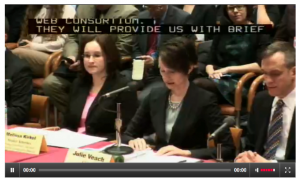By Jennifer Ensign
Kim Marr recalls that she was 19 years old and four months pregnant when her husband first hit her. She didn’t know what had happened because she was knocked unconscious and fell to the ground.
Marr said she quickly forgave her attacker. “I heard those magic words: ‘I promise I’ll never do it again,’” she recalled. But during their three-year relationship, Marr said, she heard that promise too many times to count. Her boyfriend apologized, then offered her flowers and other conciliatory gestures.
Marr’s experiences fall into a common pattern in domestic violence situations known as the cycle of abuse.
Lolita Sanders, an administrator at Family Rescue, Inc., one of the largest domestic violence shelters in Chicago, described the cycle of abuse in three stages: honeymoon, tension building and the explosion.
“The honeymoon stage is when everything seems to be going great,” she said. That stage is followed by an argument and tension over something relatively minor that upsets the abuser; for example, an abusive man might become unnecessarily upset when his wife arrives home from work later than expected.
“Then something happens to set the abuser off, which leads to the verbal or physical abuse, otherwise known as the explosion,” said Sanders.
The cycle of abuse is experienced by many women in all parts of the United States. The U.S. Department of Justice reported that approximately 1.3 million women each year are physically assaulted by an intimate partner nationwide. Intimate partner violence made up 20 percent of all nonfatal violent crime experienced by women in 2001, the department said.
Marr, now 52, a psychologist and living in Darien, recalled a time when the “explosion” caught her off guard.
“I had been out with my friend Terri, who he didn’t like and saw her as a threat, because he didn’t want me to have any friends. I was going to pick up our son from his crib when he grabbed me from behind in a chokehold,” said Marr.
She suffered two black eyes and her second concussion in three months. Marr decided she needed help, but because she was young and financially dependent on her boyfriend, she thought she had few options.
Like Marr, many victims of domestic violence feel trapped.
“Some women find it easier to stay when they rely on their abuser for their finances or when the sole income is coming from the abuser,” said Anuja Mehta, spokeswoman for Apna Ghar, a North Side shelter that primarily serves women of Southeast Asian descent and other minority groups.
Mehta noted that in many abusive relationships, the abuser is much older than the victim and their extended family plays an integral role in their lives.
“You expect a woman to leave all that?” she asked. “It’s almost unheard of in some cultures for women to leave.”
Most therapists who work at shelters say they are careful not to judge a victim.
“I let the person tell her story,” said Mehta. “I don’t give my opinions. I don’t say, ‘I think you should leave.’ If she returns home, I don’t pass judgment.”
She said one of the first things she does when assessing a victim of domestic violence is to create a safety plan for her.
“This entails putting all of your important documents, i.e., birth certificate and Social Security card, all in one easily accessible place, so when you do leave, you can grab your things quickly,” she said.
She also instructs the victim in ways to defend herself, by pulling her forearm across her face when her attacker approaches her. Mehta suggests to victims that they hide the knives and other potential weapons in their homes.
Other therapists recommend that a woman not allow herself to be in a bedroom with an attacker because he can easily block her exit through the single doorway.
Marr remembers calling her brother for help. “He lived too far away, so I ended up calling my abuser’s parents,” said Marr. Her boyfriend had blackened both her eyes, taken their son and left with him in their car.
“He knew our son was the best way to get at me; if he had control of him, he had control over me,” said Marr, adding that it would have been easier to leave if she had had more money or a college education. “When you’re younger, you think you can handle more.”
Jeff Kiser, Marr’s brother, remembers showing up at his sister’s apartment with a baseball bat in hand and no idea what to do next.
“When my sister called me, I didn’t wait for an explanation. I grabbed my Louisville Slugger and got in my car and drove. When I got to the house, Kim answered the door with two black eyes, and [her boyfriend’s] parents standing behind her. I had to put the bat down,” he said.
Another problem many victims face is whom to contact for help, said Bobbie Gordon, a licensed clinical social worker at Shalva, a North Side center for Jewish victims of abuse. Gordon said some religions teach women to take care of their husbands, no matter how they treat their wives.
Relatives of an abuse victim might advise her to “just cook him a nice dinner,” she said.
Marr said she got similar advice from her abuser’s father.
“When his parents came over, his father, who was very old fashioned, first suggested to me that I take him out to a nice dinner, or just stop hanging out with Terri,” Marr said.
She had also gone to the police, but had received no help or sympathy. “No one would help me,” she said. “It was as if they didn’t believe me or didn’t want to.”
She suggested attitudes toward domestic violence have changed significantly.
Chicago Police Officer Gabriel Rodriguez, a domestic violence liaison in the South Loop, agreed that more officers are trained in how to handle domestic abuse.
“Historically, a police officer would arrive on the scene, witness the altercation, and tell the abuser to take a walk and cool off,” he said.
In 1986, the state legislature passed the Illinois Domestic Violence Act, which defined domestic violence and created greater awareness. The law requires domestic violence liaison officers to go through a court-mandated 60 hours of domestic violence training, according to the Chicago Police Department.
Marr said although she was quick to blame others, she also began to blame herself for suffering abuse.
“It’s almost impossible not to feel as if it is your fault. I kept telling myself if I were just a better person, this wouldn’t have happened to me,” she said.
Marr and her husband were together for almost three years, and it took her five years to divorce him. “I moved with my son to Florida to stay with my mother, and he followed us there,” Marr said. He stole a blank check from Marr, and she didn’t see him again for 22 years.
“Overall, although what he did to me was unthinkable, I think what he did to his son was much worse,” Marr said of his abandonment of his child.
Almost 30 years after the abuse, Marr said she was one of the lucky ones who got out just in time.

![Reblog this post [with Zemanta]](http://img.zemanta.com/reblog_c.png?x-id=a716520a-f14b-4d48-bf7e-cf011648115c)










Be First to Comment